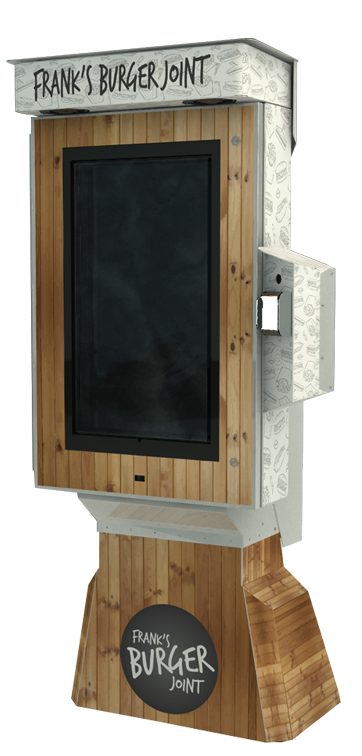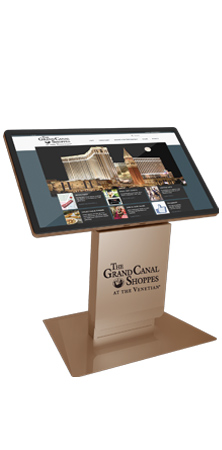
Table of Contents
Interactive Touchscreen Comparison
 Introduction
Introduction
Interactive touchscreens come in several varieties. Here’s a quick overview of the types and the applications to which each is best suited. Whitepaper by Olea Kiosks
Although interactive touchscreens have been around in one form or another since the late 1970s, over the past 10 years or so they’ve become an integral part of our lives.
In fact, thanks to the iPhone, tablet computers and similar devices, we’ve become accustomed to the idea that we should be able to touch the screens we see and get a reaction. Interactive touchscreens are a central feature of devices ranging from ATMs to wayfinding kiosks to the photo kiosks common in drugstores around the country.
A Research and Markets study valued the size of the interactive display market at $9.9 billion in 2015, with that market estimated to increase at a compound annual growth rate of 15.5 percent over the next five years, reaching $26.9 billion by 2022.
Interactive displays include a variety of technologies, though, and not every technology is suited to every application.
Touchscreen Type
Stacking them up
According to the industry trade publication Control Design, there are five main types of touchscreens: resistive touch, infrared touch, surface capacitive, surface acoustical wave and projected capacitive. Each has its advantages, disadvantages and applications for which it is best suited.
Resistive Touchscreen
A resistive touchscreen is made up of several thin layers, including two electrically resistive layers facing each other with a thin gap between. When the top layer is touched, the two layers connect and the screen detects the position of that touch.
“Resistive touch is a very old technology that some companies still offer as their go-to,” said Frank Olea, CEO of Olea Kiosks.
“It works great in places with dust and grease, such as fast food restaurants, and its low price point can make it attractive for those with a limited budget,” Olea said. “I personally don’t care for it because it makes the image on the screen appear hazy and it wears out over time.”
In addition, resistive-touch screens are unable to perform the multitouch functions that are becoming increasingly popular.
 Infrared Touch
Infrared Touch
For very large displays, infrared touch is the most common application. Instead of a sandwich of screens, infrared touchscreens use IR emitters and receivers to create an invisible grid of beams across the display surface. When an object such as a finger interrupts the grid, sensors on the display are able to locate the exact point.
Advantages of infrared touch are excellent image quality and a long life, and they work great for gesture-based applications. In addition, scratches on the screen itself won’t affect functionality. In many cases, touch capability can be added to a display through the use of a third-party overlay placed on the existing screen.
On the downside, infrared touchscreens are susceptible to accidental activation and malfunctions due to dirt or grease buildup. They’re also not suited to outdoor applications. In addition, while adding an overlay is a relatively quick way to convert a large display into a touchscreen, extra care must be taken in mounting that overlay to ensure touches match the image displayed on the screen.
Surface Capacitive Touchscreeens
Surface capacitive screens have a connective coating applied to the front surface and a small voltage is applied to each corner. Touching the screen creates a voltage drop, with sensors on the screen using that drop to pinpoint the location of that touch. Advantages of surface capacitive technology include low cost and a resistance to environmental factors, while disadvantages include an inability to withstand heavy use and a lack of multitouch capability. Those screens are also limited to finger touches; the technology won’t work if the user is wearing gloves. DVD rental company Redbox uses surface capacitive screens in their kiosks.
Multitouch Touchscreen Technology
Other types of touchscreen tech offer the potential of more complicated functions thanks to their ability to sense several touches at the same time. Multitouch applications might include functions performed with two or more fingers, such as pinching or zooming of images. Larger displays might allow for interaction using two hands or even two users.
SAW Touchscreen
Surface acoustic wave or SAW displays use piezoelectric transducers and receivers along the sides of the screen to create a grid of invisible ultrasonic waves on the surface. A portion of the wave is absorbed when the screen is touched, with that disruption tracked to locate the touch point.
“We tend to lead with surface acoustic wave,” Olea said.
“The transparency of the glass on an SAW panel is pretty good and the touch tends to be very stable and not require frequent calibration,” he said. “On the other hand, it doesn’t work well outdoors or anywhere there is grease or high amounts of dust, such as near parking lots, in warehouses things like that. Also, you can do 2-point touch on SAW although pinching, zooming, and applications such as on-screen signatures don’t work very well.”
Projected Capacitive or PCap Touchscreens
Last on the list of dominant touch technologies is projected capacitive technology. PCAP is a relative of capacitive touch, with the key difference being that they can be used with a stylus or a gloved finger. Projected capacitive touchscreens are built by layering a matrix of rows and columns of conductive material on sheets of glass. Voltage applied to the matrix creates a uniform electrostatic field, which is distorted when a conductive object comes into contact with the screen. That distortion serves to pinpoint the touch.

Projected capacitive and its cousin surface capacitive are relatively new technologies, similar to what’s in a smartphone. Both offer opportunities not possible with resistive and infrared touch screens.
“Capacitive technology is born and bred for multi-touch,” Olea said. “And because the touch technology is embedded in the glass it offers superior resistance to wear, vandalism and gives you a very clear, bright screen.”
Olea uses projected capacitive technology in all of its outdoor kiosk products.
“Projected capacitive screens are still fairly expensive compared with other types of touchscreens, mostly because the technology is new and there isn’t a ton of high-quality manufacturers out there making them,” Olea said. “Metal can also interfere with the function of the PCAP technology, so the integrator or kiosk designer should know what they are doing to ensure the product works as advertised.”
Choosing a Touchscreen
The final determination
Ultimately, the type of touchscreen a deployer chooses to incorporate into their application will be determined by factors including the deployer’s budget, the environment in which the device will be placed, the function the device will perform and the deployer’s plans for any future applications.
Order entry screens in the kitchens of a small fast-food restaurant chains would obviously call for resistive touch technology, for example, while a 72-inch display in a hotel lobby or shopping mall would call for infrared touch. An “endless aisle” or catalogue lookup kiosk where a shopper may want to enlarge an image of a particular product might work fine with a surface acoustic wave or surface capacitive screen, while wayfinding kiosks on a college campus or city street would likely call for projected capacitive technology.
Perhaps the deployer has plans to implement more advanced functions down the road, and wants to future-proof their investment. In that case, they may need to choose between a surface capacitive or projective capacitive screen.
At the end of the day, the best way to choose a touchscreen best suited to the application for which it will be used is to work with an experienced kiosk vendor who is well-versed in the ever-changing regulatory environment. Olea Kiosks stands ready to help.
ADA and Accessibility Touchscreen Access
One interesting aspect of touchscreens is which ones should I use for disabled users with prosthetics?
The answer is you need to use Infrared or Resistive touch technology as the prosthetic will generally not have a path to ground and that is required for something like PCap.
Related Posts
